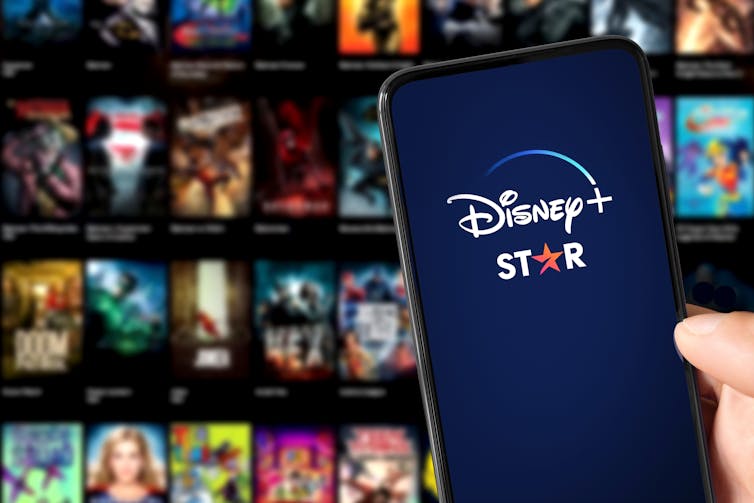A true crime series about male strippers, arson and murder-for-hire, marketed with lines like “Women get horny!” and “Blood will spill”? It’s safe to say that Disney+ isn’t the most obvious destination for a show like Welcome to Chippendales.
On the surface, the commission looks risky – a borderline negligent brand mismatch. Surely Welcome to Chippendales’ violent and sexual content threatens the wholesome, family-friendly reputation Disney has spent decades building up, exploiting and preserving? Surprisingly, no – but this isn’t anything to do with the series itself.
Welcome to Chippendales is a great example of the control Disney now has over its brand and the ways it takes advantage of streaming technologies to ensure shows circulate with the “right” audiences.
Central to the emergence of edgy, adult-only content on Disney+ was the introduction of its new, adult-oriented Star content hub in February 2021. Nomad (the agency behind the Disney/Star branding) explained that “the new identity system serves as a protective layer between [Star’s] content and the Disney brand, ensuring the two worlds never collide.”
Releasing provocative content such as Welcome to Chippendales under “Star Originals” rather than Disney reduces the chances of unwanted associations rubbing off on the House of Mouse.
Separation or synergy?
Brand managers call this “brand architecture” – the ways conglomerates manage the relationship between their different brands. The dilemma is whether to aim for separation (shielding brand identities from the potential failings of others) or synergy (encouraging cross-promotion and valuable brand overlaps).
Disney is well known for its hybrid approach, running a number of divisions that are clearly branded as arms of Disney (such as its parks and resorts, Disney Cruises and Disney Stores), while others appear to outsiders as autonomous companies (for example, Marvel and ESPN).
Star originally came into the Disney fold in 2019 as part of a US$71 billion (£58 billion) deal to acquire 21st Century Fox. Since then, Star has emerged as the conglomerate’s go-to label for separating its more provocative Disney+ titles from the rest of its content.

It’s a strategy the company has used for the best part of 30 years, with varying degrees of success. When Disney acquired Miramax in 1993, the studio was the most exciting name in indie cinema, responsible for distributing films like Sex, Lies and Videotape (1989) and Reservoir Dogs (1992).
It behoved Disney to get into bed with such a hot property, enabling it to reach discerning new audiences, university educated with high incomes. But keeping the two brands separate at the corporate level was not always enough to stop their reputations bleeding into one another.

Critics worried that Disney might sanitise Miramax, while Miramax’s devil-may-care attitude towards controversy looked like a Disney PR disaster waiting to happen. As Miramax released films like Kids (1995) – featuring sexually active, drug-using teenagers – and Kevin Smith’s divisive religious satire Dogma (1999), the relationship became a major problem.
The backlash to Kids was fierce enough that protest groups called for a Disney boycott. Miramax owners Harvey and Bob Weinstein had to resort to extreme measures to resolve the fiasco, buying the rights themselves and creating a standalone, unaffiliated distribution company purely for Kids.
Meanwhile, Miramax sold Dogma’s North American rights to Lionsgate, sacrificing millions in box office revenue in order to avoid the wrath of the US religious right.
Same show, different label
Disney has spent decades engaged in internal gerrymandering, looking to create separations or synergies between its sub-brands. But in today’s streaming era, the studio can shift its borders more easily than ever before.
This is especially evident with Welcome to Chippendales, because the series appears under a different company name depending on how and where you encounter it.
For example, when it debuted in the US in November, Welcome to Chippendales wasn’t on Disney+ at all and there was no Disney branding to be seen on any of its promotional materials. As was the case with the sexually explicit Pam & Tommy (2022) and addiction-themed Dopesick (2021).
These series were branded in the US as Hulu Originals. Hulu is owned by Disney, but has its own platform with different content.
In the UK, the distinction between brands is less stark. Welcome to Chippendales appears under the Star tile, but is part of the same platform as the content from other Disney divisions and sub-brands (appearing in “New to Disney+”).
Intriguingly, the Star brand is featured more heavily on the platform itself, whereas UK marketing materials for the series have focused almost exclusively on Disney, not mentioning Star at all. Presumably this is because of Star’s lower brand recognition in the UK and the need to direct consumers to the viewing platform.
For Disney, all of this represents an unprecedented level of control over its intellectual property. Circulation can now be tailored to the whims and habits of different territories and demographics, without any need for elaborate or last-minute changes to distribution deals.
It’s as quick – and impressive – as ripping off a pair of Velcro trousers.
Richard McCulloch does not work for, consult, own shares in or receive funding from any company or organization that would benefit from this article, and has disclosed no relevant affiliations beyond their academic appointment.
This article was originally published on The Conversation. Read the original article.







